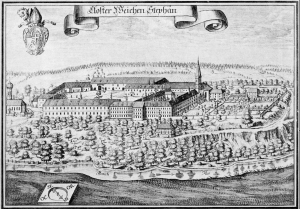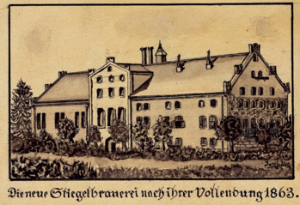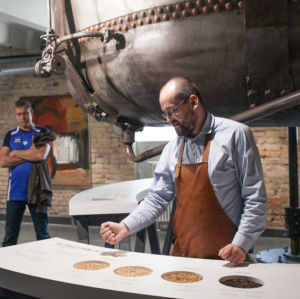Beer as European Heritage
Europe is today considered the center of beer culture in the world. Although beer has existed since ancient times and has been produced in a wide range of cultures and civilizations, it has developed as a typical European drink since the medieval period. Many monasteries in medieval Europe began producing beer as a means of […]
Europe is today considered the center of beer culture in the world. Although beer has existed since ancient times and has been produced in a wide range of cultures and civilizations, it has developed as a typical European drink since the medieval period. Many monasteries in medieval Europe began producing beer as a means of preserving grains, of drawing on and paying for labor, and of feasting. The demand for beer increased with the development of maritime economies in the Early Modern period as it could attract sought-after sailors and be preserved during long sea voyages. The Industrial Revolution witnessed another sharp in jump with the spread of consumption amongst factory workers due to improved incomes, the establishment of large industrial breweries, and the mass production of beer and cheap prices. Europe can justifiably lay claim to being the cradle of modern brewing, with the huge majority of today’s beer styles. The styles that dominate the global beer markets have their roots in Europe’s breweries and European beer brands. Beer drinking has become in Europe an important social practice, a marker of identity and source of many festive events. Traditional knowledge in the production of beer has been developed and transmitted from generation to generation. There are a large variety of brewing methods and practices in all European countries that contribute to the economic and social development of communities and to cultural life.
Europe’s brewers are today at the forefront of global expertise, with major brewing schools based in Europe and Europe’s master brewers taking their craft to all four corners of the world, assisting with the spread of beer culture. Europe also has the highest concentration of breweries in the world, the highest rates of beer consumption per capita, and the highest revenues from beer sales.
The beer industry in Europe is a growth sector: the number of breweries have almost doubled since 2010 and the export of beer is increasing rapidly. Out of the top ten agricultural food export sectors, beer is currently Europe’s fastest growing in terms of trade value.
The History of Beer in Europe
Ancient clay tablets show that the brewing process dates 
Alulu beer receipt – This records a purchase of « best » beer from a brewer, c. 2050 BC from the Sumerian city of Umma in ancient Iraqback more than 6 thousands years in the present day country of Iran. A 3900-year-old Sumerian poem honoring Ninkasi, the patron goddess of brewing, contains the oldest surviving beer recipe, describing the production of beer from barley via bread. In Ancient civilizations, archaeological records indicate that brewing alcohol was primary a domestic activity engaged in by women.
Beer may have been known in Neolithic Europe as far back as 5,000 years ago, and was mainly brewed on a domestic scale. As far as we know, beer brewing largely remained a home activity throughout the medieval period. It wasn’t until the 10th century that European cities became populous enough to support actual brewers and breweries. By the 14th and 15th centuries, beer making was gradually changing from a family-oriented activity to an artisan one, with pubs and monasteries brewing their own beer for mass consumption. Beer production then becomes a masculine activity.
Despite its age, the basic recipe for beer has remained surprisingly constant throughout the centuries. While the brewing process relies on steps that have remained fundamentally unchanged (malting, brewing and fermentation). A number of innovations have nonetheless improved the quality of the beer produced and extended its shelf life. One of these innovations was the use of hops, which became common practice in the 15th century.
However, it is the Industrial Revolution that gave rise to a number of technological innovations that have remained important to this day, such as the development of pressurized, filtration, and racking techniques, bottling technology, refrigeration, etc. The research carried out by Louis Pasteur also led to a better understanding of the fermentation process, of the conservation of beer, as well as a substantial improvement in the sanitary conditions.

Founded in 1040, Bavaria (Germany). The world’s oldest continuously-operating brewery was born within Weihenstephan Abbey, before being secularized in 1803. Still in service. In the Medieval tradition, every monastery brewed its own beer.The ten oldest breweries in the world still in operation to day are all of European origin.
Founded in 1040, Bavaria (Germany), the world’s oldest continuously-operating brewery was born within Weihenstephan Abbey, before being secularized in 1803.
- WELTENBURG ABBEY BREWERY, 1050 (Kelheim, Germany)
- BOLTEN BREWERY, 1266 (Korschenbroich, Germany),
- PRIVATBRAUEREI GAFFEL BECKER & CO, 1302 (Cologne, Germany)
- AUGUSTINER-BRÄU, 1328 (Munich, Germany)
- HUBERTUS BREWERY, 1454 (Near Laa an der Thaya, Austria)
- STIEGL BREWERY, 1492 (Salzburg, Austria)
- GROLSCH BREWERY, 1615 (Groenlo, Netherlands)
- SMITHWICK’S BREWERY, 1710 (Kilkenny, Ireland)
- ST. JAMES’ GATE BREWERY, 1759 (Dublin, Ireland)

Stiegl, Austria, 1863Europe is today the biggest producer of beer in the world just behind China with a total production of 384 million hectoliters in 2014 for which 77 million are exported. According to the Brewers Association of Europe, has some 9 500 breweries, 80 beer styles and more than 50 000 different beer brands. Germany is by far the first European producer of beer with 8,1 billion liters per year which makes up about 20% of total European production. It is followed by the United Kingdom with some 5,6 billion liters and Poland with 4 billion liters. The Netherlands and Belgium are the leading European countries in the export of beer. The Czech Republic has the highest rate of consumption per inhabitant with an average of 143 liters per inhabitant per year.
The Heritigization of Beer or the Turning of Beer into a Heritage Product
The Birth of the Microbreweries or Craft Breweries
One of the first expressions of heritagization of beer is the rapid development of craft breweries. A large number of microbreweries have sprung up over the years. Countries such as Germany, Belgium, England and many others are returning to their roots and revisiting traditional brewing techniques. Craft breweries are considered a means of developing a sense of belonging to place, to local customs and to specific groups, as well as a means of drawing outsiders (ie tourists) to these places. « The growth of craft beer connect to trends like the farm-to-table movement, gentrification, the rise of the « creative class, » and changing attitudes toward both cities and farms[1] ». According to the Financial Times, there was a 73% rise in the number of craft breweries over the last five years, with 5 665 breweries now operating in Europe. It reports that brewery numbers quadrupled in France and Spain, and more than doubled in Italy, Poland and Norway in the period 2008-2013.
The development of Beer Museums

Beer Museum, Riga, LatviaIn recent years, beer museums have sprung up in many European countries to valorize beer by showing brewing techniques and process, its history and artifacts[2]. “The majority of beer museums are located in Europe where the cultural value and historical significance of beer is more prominent than anywhere else in the world[3]”. Belguim and Germany each have ten beer museums. [4]. The European Beer Museum, located in Stenay (France), is the only one of its kind in Europe for the size of its collections (50 000 items) and its sheer size (2 500 sq.meters).
Celebrating Beer Through Festivals

Munich, OktoberfestBeer is being celebrated and made into heritage in Europe through festivals. The world’s largest beer festival is held in Munich. Founded in 1810, l’Oktoberfest is today the largest beer festival in the world attracting some 7 million visitors during a two week period in October. Beer consumption reaches here its heights ; purchases can only be made for one liter glasses. Almost as well known in Germany is the Stuttgart Cannstatter Volksfest which also attracts millions of visitors. There are dozens of other beer festivals in Europe, such as the Barcelona Beer Festival in Spain and the Pilsner Fest in The Czech Republic. Organized by the famous Mikkeller Brewery, tbe Copenhagen Beer Celebration, brings together each year more than 60 brewers from around the world. The festival lasts a whole week with two days dedicated to beer tasting. In recent years, « Craft Beer Festivals » are gaining in popularity, such as the London Craft Beer Festival, the Irish Craft Beer Festival in Dublin, the Warsaw Beer Festival in Poland, and the Borefts Beer Festival in the Netherlands.
Visiting Breweries as Places of Heritage
Historic breweries have themselves become places of heritage visited by hundreds of thousands of visitors each year. For example, the Heritage Brewing Company, established in the heart of the National Brewery Centre, Burton upon Trent, UK has a mission to recreate classic beers of the past for a modern audience. Utilizing an impressive 25 barrel brewery built in 2011 and situated in the heart of the Museum, The Heritage Brewing Company is combining the history and atmosphere of the National Brewery Centre with state of the art equipment and modern brewing techniques to produce a range of beers which recreate brewing history and at the same time provide a range of tastes and flavors of the highest quality. The « Belgian Beer Routes » gives visitors the opportunity to discover the oldest breweries of Belgium and to practice beer tasting along the way. The Straffe Hendrik Heritage Brewery offers every Fall a limited edition of beer that has brewed for a year in Bordeaux oak barrels.
European Beer at UNESCO
The most prestigious recognition in recent years of European beers as heritage has been the inscription of Belgium beer culture on the Representative List of Intangible Cultural Heritage at UNESCO in 2016.
Laurier Turgeon
Bibliography
Bourgeois, Claude, La bière et la brasserie, Paris, PUF, 1998.
Chapman, Nathaniel G., J. Slade Lellock, Cameron D. Lippard (ed.), Untapped : Exploring the Cultural Dimensions of Craft Beer, Morgantown, West Virginia University Press, 2017.
Garrett, Oliver and Tom Colicchio (ed.), The Oxford Companion to Beer, London, Routledge, 2011.
Nelson, Max, The Barbarian’s Beverage: A History of Beer in Ancient Europe, London, Routledge, 2005.
Schiefenhövel, Wulf and Helen Macbeth, Liquid Bread: Beer and Brewing in Cross-Cultural Perspective, New York and London, Berghahn, 2014.
Smith, Gavin D., Beer : a Global History, London, Reaktion Books, 2014.
Webb, Tim and Stephen Beaumont, L’atlas mondial de la bière, Montréal, Editions Québec Amérique, 2012.
[1] Chapman, Nathaniel G., J. Slade Lellock, Cameron D. Lippard (ed.), Untapped : Exploring the Cultural Dimensions of Craft Beer, Morgantown, West Virginia University Press, 2017, p. 5.
[2] Heineken Museum, Amsterdam; Guinness Storehouse, Dublin ; Copenhagen, Carlsberg Visitors Centre ; Aldaris Beer Museum, Riga, Latvia ; Heritage Brewing Co (Burton Upon Trent, UK); Museu da Cerveja, Lisbon, as well as beer museums in Prague, Austria, Czech Republic, Netherlands; Estonia, etc.
[3] « Beer Museums », in The Oxford Companion to Beer, Oliver Garrett and Tom Colicchio (ed.), London, Routledge, 2011, p. 886.
[4] Id. p. 886


 Université Jean Monnet
Université Jean Monnet